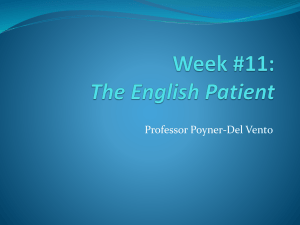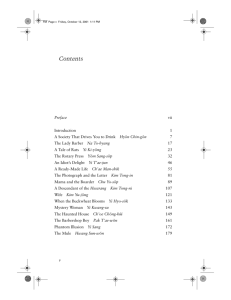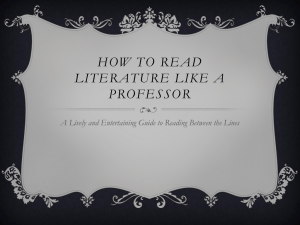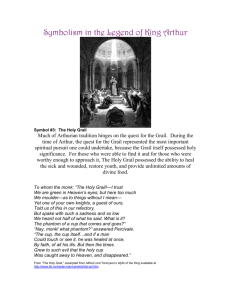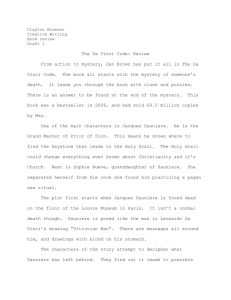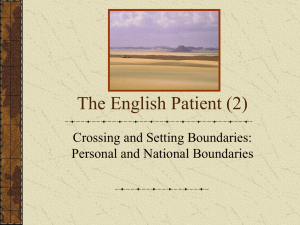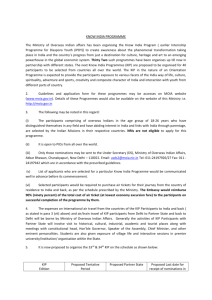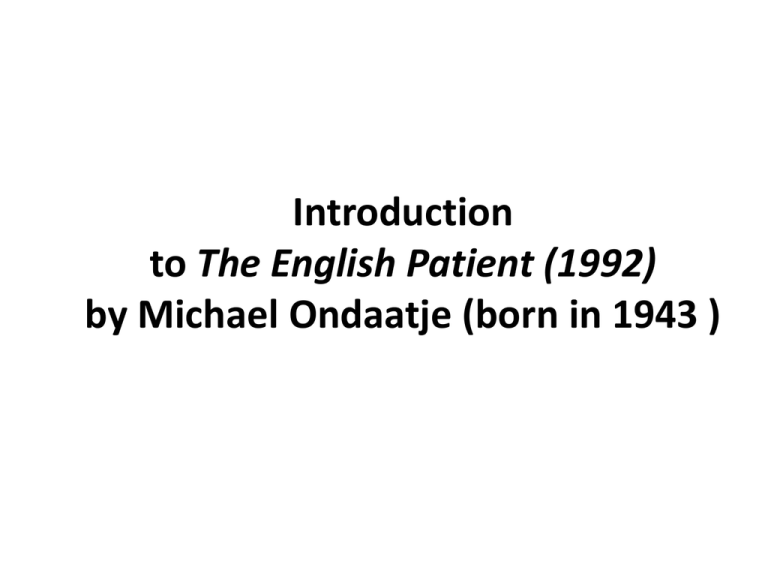
Introduction
to The English Patient (1992)
by Michael Ondaatje (born in 1943 )
• Son of a tea and rubber plantation
superintendant
• Born in Sri Lanka
• After his parents’ divorce, at 11, moved to
England with his mother
• Came to Canada in 1962
• B.A. from the University of Toronto (1965)
• M.A. from Queen’s University in Kingston
• Taught at the University of Western Ontario
(1967-1971)
(on writing roots, DVD, 5 min. + on the Booker prize , DVD, 3 min.))
Introduction
• exiles, international bastards
• cultural hybridity (on Ladislaus de Almasy, the “oasis” society, DVD, 8 min.)
• all the individuals in the villa have endured
physical and psychological wounds
• nationalism is implicated in their suffering
• the theme of betrayal
(p. 176)
( p. 41)
The Ex-centric Subject
(unstable, shifting identities)
- no clarity in the definition of one’s identity
(Ondaatje 8-9)
- the migrant’s double perspective (the EP and Kip)
- no face – no identity
- erasure of physical and national identities (“a
void” filled by others through projection of their needs)
- an identity that resists final definition (e.g. Kip’s
in-between identity of a migrant; the EP)
- the reversal of the espionage plot
- finding new identities
(252)
(117)
The body as site of resistance
- the body is shown to be subjected to
a range of technologies of control
- the body can also be a site of
resistance: celebration of the body’s
potency
- transformation from the habitual
self into a more timeless figure
- the body is the site of very different
forms of semiotic exchange
(37-38);
(248)
Masculinity, sexual desire and
identity
- masculinity and sexual desire
and exploration of the politics of
identity
- “the male chaotic”
(Lorraine York )
- the male hero’s defiance of social
law and principles of order
- a shift from Ondaatje’s earlier
valorization of an extreme
masculinity
- a re-evaluation of male sexuality,
masculinity (Susan Ellis)
- the territorial possessiveness of
the European cartographers and
the sexual possessiveness
- the contrasting relationships of
Almasy and Katharine, and Hana
and Kip
(230)
- Almasy and Katharine’s relationship
is based on a disassembling of social
selves, on dissolution of identity, on
breaking down demarcations of
geography, race and body.
- Hana and Kip’s relationship is based
on the preservation of the integrity of
their separate selves,intersubjectivity,
a mutual respect for the interests of
the other.
Reversals:
viewing vs. being viewed
subject vs. object positions
( the EP- Katharine, 144)
(Caravaggio-Hana, 81)
Postmodernism, history and The EP
• Postmodernism shows a distrust of dominant
narratives of the past
• The Canadian cultural context is characterized by
“pluralism, decentralization and the creation of
a multi-cultural ‘mosaic’” (Maver)
• Postmodernist novels seem to be part of
historical discourse, but at the same time they
proclaim their status as fiction. (They make use
of the conventions of realism only to parody
them)
The conflict between oral and written
records (L. Hutcheon)
• The oral mode is based • The written mode is
on “gossip and
linked to cause-andcommunal (mythic)
effect rationality,
memory;
rationalism of the
historical narrative
• is tied to myth, legend
and fairy tale (232-237)
• Ex. Almasy’s written
diary
• Katharine’s assimilation
into communal, oral
memory
• Blurring of the distinction between fact and
fiction (Herodotus himself was called both
“the father of history” and “the father of
lies”)
Histories are characterized by
• a persistent instability in the evidentiary
status of its narrative instability and constant change (142)
• The rejection of the single authoritative
version of the past in favor of a record of the
multiple voices that constitute a communal,
oral record.
– the EP about Herodotus (18-119)
• There’s a similar instability in The
EP, where passages in the mode of
the classical historical novel
contrast with the EP’s
handwritten narrative which draws
on the memory bank of oral
tradition
often drawn from
Herodotus
(135-140, the account of the
expeditions)
(97, on betrayals)
• Amasy’s identity proves to be elusive in the
historical sources, which provide
contradictory accounts of his aristocratic
status.
• By making this shadowy figure the hero of
this novel, O. reverses the centre/margin
relationship of conventional stories.
• O.’s combination of the historical and the
fictional exemplifies a characteristic strategy
of postmodernist fiction, the “use of the
double referent”.
Intertextuality
• Its main assumption is that any particular
text will derive its narrative structures ,
themes, models of character in part from
previous texts (e.g. the Canadian postmodern
fiction is characterized by the parodic use of
traditional forms and conventions – biblical
narratives, or narratives of quest) The irony
and distance involved in parody allows the
text to separate itself from the original while
recognizing its complicity with it.
The EP and the Grail legends
(Bill Fledderus)
• The Waste Land by T. Eliot and The
EP vs. the Grail legends
The Fisher King
The ‘Grail King’ - the guardian of
the Holy Grail. The Grail is
regarded as Holy because it was
said to have carried Christ’s blood
and was thus imbued with his
qualities. In psychological terms it
symbolizes the infinite
possibilities of the emerging Self.
The Fisher King is our unconscious
guide, forever casting his net in an
effort to draw the sparkling facets of
understanding, compassion,
individuality, love, or simply, the
realization of Christ, up from the
formless sea of unconsciousness into
the light of awareness. It is an
underlying theme recognizable in
most of the World’s religions.
The Grail Legends and The EP
• The Fisher King and the fertility myths
• The land is ravaged; the king is maimed
and impotent
• The curse is lifted with the arrival of a
knight who must successfully undergo
certain trials, sometimes aided by the
Grail maiden.
• Once he has done this, fertility is
restored to the land.
Similarities between the Grail legends
and The EP
The Grail legends
• “the destroyed chapel”
• the pattern of sterility and
desolation followed by
renewal of life and fertility
• Fisher King’s thighs are the
most damaged parts of his
body (associated with
impotence)
• Some of the Grail legends
describe a dead king lying on
an altar in a candlelit room
The EP
• the villa(11)
• The novel’s use of the motif
of sterility provides an
implicit commentary on the
physical and spiritual state
of a war-torn Europe, (29)
• The EP is maimed by burns
which are the most severe
in the region of the thigh (3)
• Similar in The EP
• In the Grail
legends , the
state of the land
is attributed to
political and
sexual-moral
guilt.
• The EP recognizes his
complicity with the
forces that have brought
destruction (“This
country – had I charted
it and turned it into a
place of war?)
• His adultery is an
example of sexual guilt.
(230)
• Perceval – the
knight traveller
who comes
upon the Fisher
King, and by
performing a
feat restores
the king and
the land.
• Lamenting
women that
Perceval finds
attending the
Fisher King
• The Fertility
Queen of the
Grail romances
• Kip is associated with warrior
saint and is pictured like a
travelling knight
Kip saves the land by removing
bombs
• Hana’s cutting hair is associated
with fertility rituals. Her shorn
hair may represent the failure of
earlier relationship with men,
symbolized by the aborted child
(p.85), and her response to the
prevalence of death during the
war, including that of her father.
• Hana’s hair grows after her
relationship with Kip ( 217-218); she
gardens in the wasted soil.
(273)
Hacker Arthur
Perceval with the Grail Cup
The Fertility queen - Freya
Rudyard Kipling’s Kim (1901)
and The EP
PARALLELS
KIM, p. 7, p. 118
• Kim, an orphan boy of Irish
descent, who follows a Tibetan
lama on a journey from Lahore
across India in a quest for
wisdom.
• In the course of the journey, K.
becomes involved in espionage
and is recruited by the British
officer Creighton, who educates
him in schools based on the
English model
THE EP
• Kip (a
reversal
pattern)
( 182)
• Lord Suffolk
• Assimilation
in the
English
culture
• Kim gains oriental wisdom • Kip gains
which promotes peace
Western
wisdom which
• Creighton is an ethnologist
and geographer, who shows issues in a
holocaust that
a sympathetic
understanding of the Indian destroys the
world.
customs, language and
religion, but his knowledge
is shown as a vital
• Like Almasy
instrument of political
control.
•
(111, Hana – Kim, Kip – Creighton)
The problem of identity is central to
both works as experiences by
colonized and by colonizer
KIM
The EP
• Kip is in a process of
reverse colonization
(assimilates and mimics
English customs and
• Kim’s identity is in
values)
continual transformation
• Idem
• Kim’s objective is to reclaim
his birthright and to define • Idem (Kip re-establishes his self, pp. 283-284, p. 299)
his identity (process of selfdiscovery)
• Kim assimilates and
mimics Indian customs
• Kipling’s text
• Ondaatje’s use
can be read as
of Kipling’s
a classical
intertext
defense of
involves a
British
subtle
colonialism in
subversion of
India.
its ideological
intent.
Varieties of genre and languages
Elements of postmodernism
• Parody
• Intertextuality
• Crossing of generic boundaries
(heterogeneous cultural influences;
rejection of stylistic homogeneity;
exploitation of the diversity of
genres)
The EP includes the elements of:
(Ganapathy-Dore)
•
•
•
•
•
•
the historical novel
the colonial novel
the autobiographical memoir
the epistolary novel
the detective thriller
magical realism
The EP is characterized by mixing of :
•
•
•
•
different discourses
newspaper article
popular song
comic strip
The diverse styles and discourses employed in the
narration include:
•
•
•
•
•
•
•
•
•
•
•
•
Scientific
Geographical
Cartographic
Military-technological
Military slang
Medical
Historical (the voice of Renaissance culture and of the
classicist)
English gardening and ornithology
Upper-class English
Arab culture
Mediaevalism
Erotic, etc.
The use of scientific
language
The use of “the
perception approach”
• Establishes the
aesthetic-religious
• Introduces an
response to the
empirical
world
perspective on
•
Suggest
s
a
reality and a
perspective outside
utilitarian
the Judaeoconception of value
Christian tradition
(felhomaly)
The EP
• undermines unitary cognitive modes
• is characterized by heterogeneity of
linguistic styles, by heteroglossia
(Mikhail Bakhtin) and its
decentralization which prevents the
reader from assuming that meaning
derives from a stable centre
• suggests the late twentieth century
postnational cultural politics
Ondaatje’s characters
Count Ladislaus de Almasy of
Hungary
•
•
•
•
a renowned pilot
a desert explorer
a cartographer
a member of Field Marshal Rommel’s
staff in the desert campaign of WWII
Geoffrey and Katharine Cliffton
• appear to be based on Sir Robert
Clayton East Clayton, a British baronet,
and his wife, Dorothy Mary Durrant. Sir
Robert was a pilot who flew with
Almasy in the desert, but died in 1932
of a respiratory illness.
Works Cited
Bolland, John. Michael Ondaatje’s The English Patient. A
Reader’s Guide. New York: The Continuum
International Publishing Group Ltd, 2002. Print
Eliot, Thomas Stearns. The Wasteland, Prufrock and Other
Poems. West Valley City: Waking Lion Press, 2007. Print
Ellis, Susan. “Trade and Power, Money and War: Rethinking
Masculinity in Ondaatje’s The English Patient.” Studies
in Canadian Literature, 21.2(1996), 22-36
Kipling, Rudyard. Kim. London: Macmillan, 1996
(1901). Print.
Ondaatje, Michael. The English Patient.
Toronto: Vintage Books Canada, 1993. Print.
The English Patient. Miramax Home Entertainment, 2004.
DVD.

